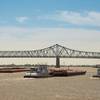By Mass Communication Specialist Seaman Hermes Crespo, Fleet Public Affairs Center Pacific
BRITISH COLUMBIA, Canada (NNS) -- U.S. Navy Sailors and American and British contractors tested a new torpedo countermeasures system aboard USS Bonhomme Richard (LHD 6) (BHR) Sept. 4-15, while underway off the Canadian Forces Maritime Experimental Test Range in Nanoose Bay.
Ultra Electronics is the developer and deliverer of reactive torpedo countermeasure systems. Ultra developed the Surface Ship Torpedo Detection (SSTD) SEA SENTOR system, currently used by the British Royal Navy, and is developing the U.S. Navy’s Detection, Classification, and Localization (DCL) Torpedo Recognition by Active and Passive Reconnaissance (TRAPR) system.
“This is a great benefit to the Navy. It’s a good opportunity for the three different countries to come together and collaborate on developing a torpedo defense system that works best for everyone,” said Lt. Mark Cummings, DCL project liaison and Bonhomme Richard information warfare officer. “This is one step in a long process that will help defend ships like Bonhomme Richard in the future.”
The tests conducted during the underway period involved firing more than 25 disarmed torpedo volleys at BHR that were detected by both the U.K. SEA SENTOR and the U.S. TRAPR DCL system while the ship conducted high-speed maneuvers. SEA SENTOR provided the ship with several options to evade the torpedoes, and the data collected by the TRAPR system gave testers a wealth of information to improve the system.
“A single torpedo can be extremely deadly and can sink a large ship,” said David Howard, vice president, Ultra Electronics Ocean Systems. “So having a system that can defend thousands of Sailors and Marines from torpedo attacks is very important to us.”
TRAPR DCL, unlike other torpedo countermeasure systems, has an active element. Sonar pulses actively search out incoming torpedoes, greatly increasing the systems protection area. The system has three defenses against incoming torpedoes and provides fire control information necessary to fire anti-torpedo torpedoes at the incoming threat.
The SEA SENTOR also has three defenses against incoming torpedoes and provides the ship with evasive maneuver strategies. It can deploy Expendable Acoustic Devices (EAD) as decoys.
This is the second time TRAPR DCL has been tested in cooperation with the U.S. Navy. The system went through initial testing aboard USS Cleveland (LPD 7) in April 2006.
Subscribe for
Maritime Reporter E-News
Maritime Reporter E-News is the maritime industry's largest circulation and most authoritative ENews Service, delivered to your Email five times per week










